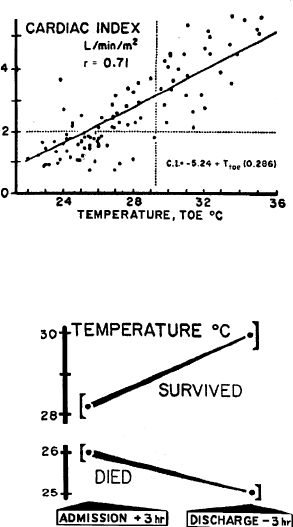
Thermal Assessment of Skin Diseases and Allergy
Temperature monitoring provides an objective assessment of skin dis-
eases
2
as well as allergy and vasomotor tests
3
since most of the skin
diseases, or the percutaneous injection of pharmacodynamic substances
used for testing, generate significant changes in the thermal pattern of
the skin.
Skin Temperature in Prognosis of the Critically Ill
Skin temperature has been the subject of several studies monitoring
blood flow in the critically ill.
Data from these studies in-
dicate increases in the tem-
perature of skin, especially
the big toe, were accompa-
nied by improvement in the
clinical status of the patient,
and significantly greater
survival. Boycks and Weil
4
concluded toe temperature
provided the best correlation
with cardiac index and prog-
nosis of survival compared
to arm, finger, thigh, or rec-
tal temperatures.
Kholoussy et al (1980)
5
demon-
strated attainment of normal rec-
tal-toe temperature gradient con-
sistently coincided with hemody-
namic stabilization of the patient
as indicated by other simulta-
neously measured parameters
and by the clinical condition. In
all the patients that died, rectal-
toe temperature gradient gradu-
ally and progressively increased
as the patient’s condition became
terminal.
Monitoring central peripheral temperature gradient was determined can
accurately reflect the state of peripheral circulation, though may be lim-
ited by peripheral vascular disease, central hypothermia, and the use
of vasoactive drugs.
Toe temperature vs. cardiac index
(Boycks et al)
26
Toe temperature as a prognosis
(Boycks et al)


















